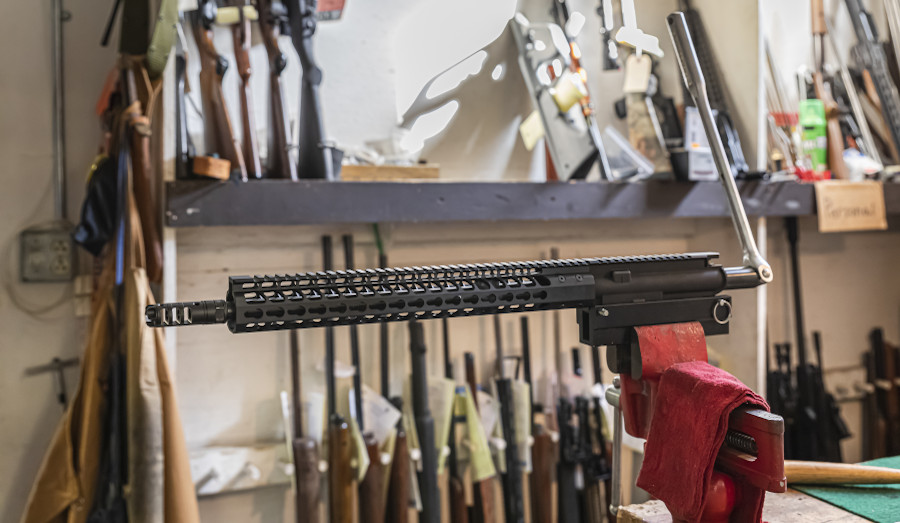With President Biden’s recent promise to use agency rulemaking to enact new gun control, Americans’ ability to build their own guns could be severely curtailed. We don’t know yet what the Department of Justice’s rule will look like, but at the very least it will try to treat “Buy, Build, Shoot” kits that package 80% receivers together with tooling and accessories as firearms. But if the administration really tries to pull one over on us, it may try to categorize all 80% receivers as firearms.
You may not be worried about this because you don’t own any 80% receivers, haven’t built any firearms from 80% receivers, and don’t plan to build any firearms from 80% receivers. But this move is an even greater infringement on our 2nd Amendment rights than any outright gun ban could ever be. This strikes at the very heart of Americans’ ability to build or repair their own firearms. And in a survival scenario, when you may not have access to a gun store, having 80% receivers and the ability to build and repair your own firearms could be the difference between life and death.
The building and assembly of firearms in the United States has long been a cottage industry. From the very first days this country was settled, home manufacture of firearms, firearms parts, and ammunition helped settlers keep their weapons in top shape to protect against Indian raids, hunt wild game, and serve in the militia. Any attempts to infringe upon the right to build our own firearms is unconscionable and un-American.
The government wants to crack down on home-built firearms because they “can’t be traced,” as though that were some legitimate concern of the government. But what is tracing really? If you use a gun and the police run the serial number, what will they be able to trace? Maybe there’s a chain of ownership available that runs from manufacturer to dealer to user, but maybe there isn’t.
If a criminal uses a gun in a crime, in all likelihood it was stolen from its original owner and changed hands numerous times. None of those transactions will be able to be traced. At best, the gun might be returned to its owner if the police feel like it. So the argument that serial-numbered guns are necessary to allow for tracing is a complete red herring, because tracing doesn’t actually accomplish anything.
Since the day of increased restrictions on home-built firearms may soon be upon us, let’s go over the three most common means of building firearms at home and how you can make them work for you. They are:
- Building from 80% receivers;
- Using a Ghost Gunner or similar machine; and
- 3D printing
There are also some hardy souls out there who have manually machined Mauser receivers from bar stock or machined raw FAL receiver forgings, but those are both far more advanced procedures and outside the abilities of most amateur machinists. In this first part we’ll take a look at 80% receivers, what they are and how to build them. In part two we’ll take a look at other methods of building firearms at home.
Building From 80% Receivers
The development of 80% receivers has been one of the greatest catalysts to the shooting community in a long time. An 80% receiver is a receiver that can eventually be built into a firearm receiver but that hasn’t had the final machining done to enable it to function as a firearm. Generally, ATF recognizes that a receiver that doesn’t have the ability to accept a fire control group is not a firearm. While there are 80% receivers available for dozens of different firearms, there are three today whose 80% receivers are the most popular:
- AR-15
- Glock 19
- AKM
1. AR-15 80% Receivers
80% receivers for the AR-15 are available in both aluminum and polymer. Polymer receivers are generally cheaper, but less durable. They are particularly prone to cracking where the buffer tube threads into the rear of the receiver. Aluminum 80% receivers are more durable and often easier to find, being made by numerous manufacturers.
Most 80% receivers already have the magazine well milled out and the buffer tube attachment threaded. The fire control group pocket is not milled out, being just one solid section of aluminum. Some models have a small pocket milled out for the rear takedown pin, to allow the 80% lower to attach to an upper receiver. But because the fire control group pocket isn’t milled out, you can’t fit a trigger, hammer, and disconnector into the receiver, thus rendering it incapable of firing.
Finishing an 80% AR-15 lower requires the fire control group pocket to be milled out, the trigger slot to be milled in the bottom of the receiver, the hammer and trigger axis pin holes to be drilled and reamed in the sides of the receiver, and the selector pin hole to be drilled and reamed. These operations are normally performed with the 80% receiver clamped into a jig.
The easiest way to finish an 80% AR-15 receiver is to mill everything on a milling machine with end mills. Some jigs are set up to allow the use of drill bits on a drill press, although that is less than ideal. Depending on the size of your mill, expect this process to take a few hours.
Although the cost of 80% receivers has gone up recently due to sellers taking advantage of the perception that they’ll be banned soon, prices generally aren’t too expensive, between $50 and $100 depending on the type of aluminum used, engraving, etc. And if you’re trying to build replicas of early AR-15s such as the first prototypes, early Air Force models, etc., you can find 80% receivers for those too, although they’re much more expensive.
2. Glock 19 80% Receivers
The most popular Glock 80% receivers available today are those from Polymer 80. The company produces 80% frames for many Glock models, including the 17/22, 19/23, and 20/21. But those for the Glock 19/23 are far and away the most popular. And with the availability of aftermarket parts for the Glock 19, it’s no surprise that most builders build their Polymer 80 frames into Glock 19-type pistols.
One of the major improvements of the Polymer 80 frame is that it gets rid of the hump on the back of the Glock pistol grip that is so uncomfortable for many shooters. And the grip angle is slightly changed too, to allow for a more natural hold. Many people choose the Polymer 80 frames specifically for that reason, preferring to pair it with the slides and upper assemblies of their existing Glock 19 pistols so that they can get Glock reliability with the comfortable hand feel of a Polymer 80 frame.
Building the Polymer 80 isn’t difficult, and can be done with a hand drill and utility knife if necessary. Having a Dremel, drill press, or milling machine can be a help, but isn’t absolutely necessary. All that needs to be done to get the Polymer 80 frame ready to accept parts is to drill a few holes and remove material in the recoil spring channel, then insert the frame parts into the frame. Because the frame is polymer (plastic), it drills and machines easily. But drilling those holes accurately is the hard part.
The Polymer 80 pistols use a combination of Glock parts and Polymer 80 parts. If you’re lucky, everything will fit together, holes will line up, and your pistol will work like a clock. If you’re not lucky, you’ll likely find that your slide catches, the pistol fails to eject, and your gun becomes a jam-o-matic. If you decide to build a Polymer 80 pistol, you’ll need to do your homework and be aware that it might take some tinkering and a few hundred rounds of ammunition before you get the kinks worked out of it.
Prices of Polymer 80 frame kits run around $149 MSRP, although street prices are often 20% lower, especially during sales. Frames are also available for the large-frame .45 ACP/10mm Glocks, although aftermarket parts for those guns are rare as hens’ teeth and quite expensive.
3. AKM-Pattern 80% Receivers
15-20 years ago, if you wanted to build an AKM-pattern rifle from a parts kit, you either bought a receiver “flat” that had all the holes pre-cut and then bent the flat in an expensive jig, or you bought a pre-bent piece of steel and cut all the holes yourself. Then you had to weld in the side rails, heat treat the axis pin holes, rivet the center support, and then you could build. Today, your options are much better.
Three companies, Recreator Blanks, Childers Guns, and AK Builder, are at the forefront of the market, offering 80% receivers to builders. The new 80% receivers come with the center support and side rails already installed and the receivers fully heat treated. You can even order them with markings to mimic those on actual AK rifles. All you have to do is drill and ream the axis pin holes, trim the ejector, and final drill and ream the trunnion holes. The quality is impeccable, leaps and bounds better than the old Tapco flats, and the cost is reasonable, ranging from $60-150 depending on what markings or receiver style you want.
If you want to go with a milled receiver AK, companies like Tortort Manufacturing offer 80% milled receivers. These require a bit more machining, requiring you to mill out the trigger slot, mill out the metal connecting the two side rails and properly size and shape the ejector, and drill and ream the axis pin holes. You’ll also have to install and rivet your own bullet guide, provide any front and rear plates you need, and rivet a lower tang if you plan to install a two-tang buttstock. Again, it’ll take a bit of machining, but the experience you gain in doing these final machining operations is well worth it.
The only downside to building AKs today is that the cheap parts kits of yore no longer exist. 15+ years ago you could get Romanian parts kits with intact barrels for $99 or less. Add in a $20 flat and $40 worth of 922(r) compliance parts and you could have a nice semi-auto AK for less than $200.
Now a parts kit, sans barrel, will run you at least $300-400, if not more. Barrels are $120-150. Tooling is expensive too if you don’t already have it. And with AKs becoming more popular among collectors and those wanting to clone specific models, parts are drying up and becoming scarce. There are also no longer any cheap surplus magazines available, thanks to no more surplus stocks coming from Eastern Europe, and Middle Eastern conflict boosting demand for AK part and accessories overseas.
This just scratches the surface of what you can do and what you can build from 80% receivers. In part two we’ll go over the other, more modern methods of homemade firearm production.
This article was originally posted on Red Tea News.





